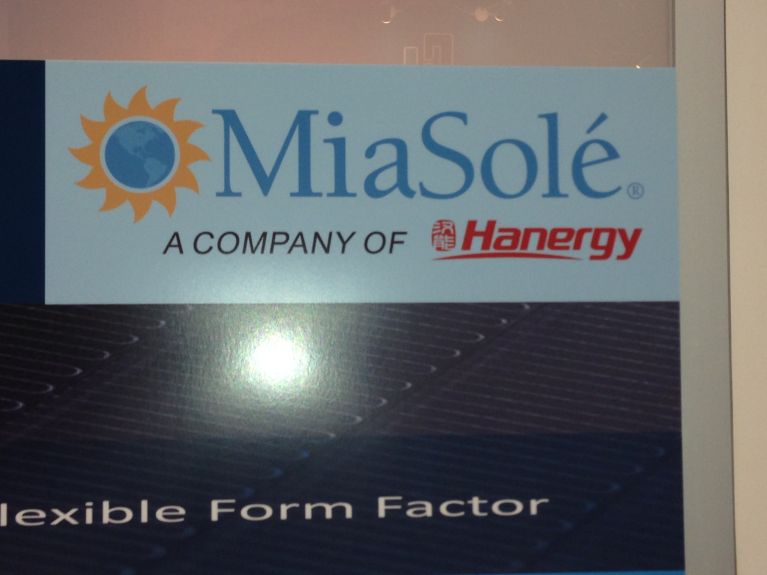The aspirational claims and investment losses in the CIGS (copper indium gallium [di]selenide) photovoltaic materials system have kept Greentech Media busy over the last few years. From Solyndra to MiaSolé to Nanosolar to AQT to SoloPower, the lure of silicon efficiency at thin film costs had long kept the CIGS hype -- and funding -- flowing freely.
Now, the funding has stopped. As has the hype.
But the efficiency numbers continue to tantalize. Manz hit a new efficiency mark for the CIGS materials system -- and while we're on the subject of CIGS, MiaSolé re-emerged at SPI in Chicago with solar panels on display as a Hanergy company, and Solar Frontier continues as the only vendor shipping CIGS product in volume.
The Baden-Württemberg Center for Solar Energy and Hydrogen Research (ZSW) hit a Fraunhofer-confirmed 20.8 percent efficiency for a CIGS thin-film solar cell, exceeding the previous 20.4 percent record. The recordsetting cell was built using the co-evaporation process, a technology shared with fellow CIGS developer Solexant. The authors of the Manz release claim, "ZSW exceeded the efficiency of today's widely used polycrystalline solar cells for the first time."
According to Dieter Manz, founder and CEO of Manz AG, as quoted in a release:
"The new world record is an extremely important step, both for our company and the industry as a whole. [...T]he only remaining disadvantage of thin-film modules compared to polycrystalline solar cells has been eliminated, the marked [sic] share of the cost-efficient CIGS thin-film technology will thus increase significantly. Our company holds the exclusive usage rights to this world-record technology, and will now transition it from the laboratory into mass production. With a record module efficiency of 14.6 percent, we have already caught up with polycrystalline technology last year; the research result of the world-record cell will help us [in] speeding up the increase of efficiency on production-size modules."
Of course, Mr. Manz is mistaken in believing that efficiency is the "only remaining disadvantage of thin-film modules" (see the case of low-efficiency thin-film leader First Solar). He's also mistaken in believing that setting the world record gets the company any closer to low-cost manufacturing.
Solexant CEO Brad Mattson has suggested that a preoccupation with efficiency records is the wrong mindset and is more an indication of an uncontrolled manufacturing process. Mattson does believe that the best process for CIGS manufacturing is co-evaporated CIGS in a roll-to-roll process, because it's "higher efficiency than anything else." Mattson also predicts that the thin film industry will be populated by five players within a few years, none of which will be Solar Frontier.
Manz has the corporate burden of offering a "fully integrated, turnkey production line for CIGS thin-film solar panels." A release claims, "The signal we are sending to the industry is clear: using a CIGSfab, manufacturers can produce panels far below the current standard costs. Thus grid parity in countless areas of the world can be achieved. A year ago, we announced that our technology has the potential to usher in a new era in the solar industry. And now we have the proof: CIGS thin film is more efficient than polycrystalline." Just to confirm, this release is from October 2013, not from 2007.
Solar Frontier might disagree with Mattson's verdict; it just announced that it has shipped 86 megawatts of its CIS thin-film panels to engineering and EPC firm Chiyoda for use in a number of projects in Japan. Like SunPower and a few other module firms, Solar Frontier is prospering in a market bolstered by Japan's generous feed-in tariff. Solar Frontier is the leader, by far, in cumulative shipments of CIGS solar panels.
Lastly, we spotted a few MiaSolé panels in the the Hanergy booth at last week's Solar Power International tradeshow in Chicago. The company showed a flexible panel with an efficiency in the 14 percent to 15 percent range and a five-year limited product warranty, as well as a glass-on-glass product with a similar efficiency range, a ten-year warranty, and a claimed "three-month energy payback." A Hanergy employee stated that the flexible product would be available in early 2014.

Here's a partial list of CIGS solar players, both active and inactive:
- Solar Frontier, 577 megawatts shipped in 2011
- Solibro, 95 megawatts shipped in 2011 (sold to Hanergy)
- MiaSolé, 60 megawatts shipped in 2011 (sold to Hanergy)
- Solyndra (bankrupt)
- Avancis
- Global Solar Energy (now selling only consumer solar products, sold to Hanergy)
- Soltecture (bankrupt)
- Nanosolar (bankrupt)
- AQT (bankrupt)
- HelioVolt (no commercial production, majority owner is SK Innovations)
- Ascent Solar (selling consumer solar chargers, majority owner is TFG Radiant)
- ISET (limited commercial production, company is transitioning to "micro-solar components")
- Stion (limited commercial production, allied with TSMC)
- SoloPower (dormant)
- Solexant (Solexant acquired the remains of Wakonda)
- TSMC (technology licensed from Stion)
- NuvoSun (acquired by Dow)



